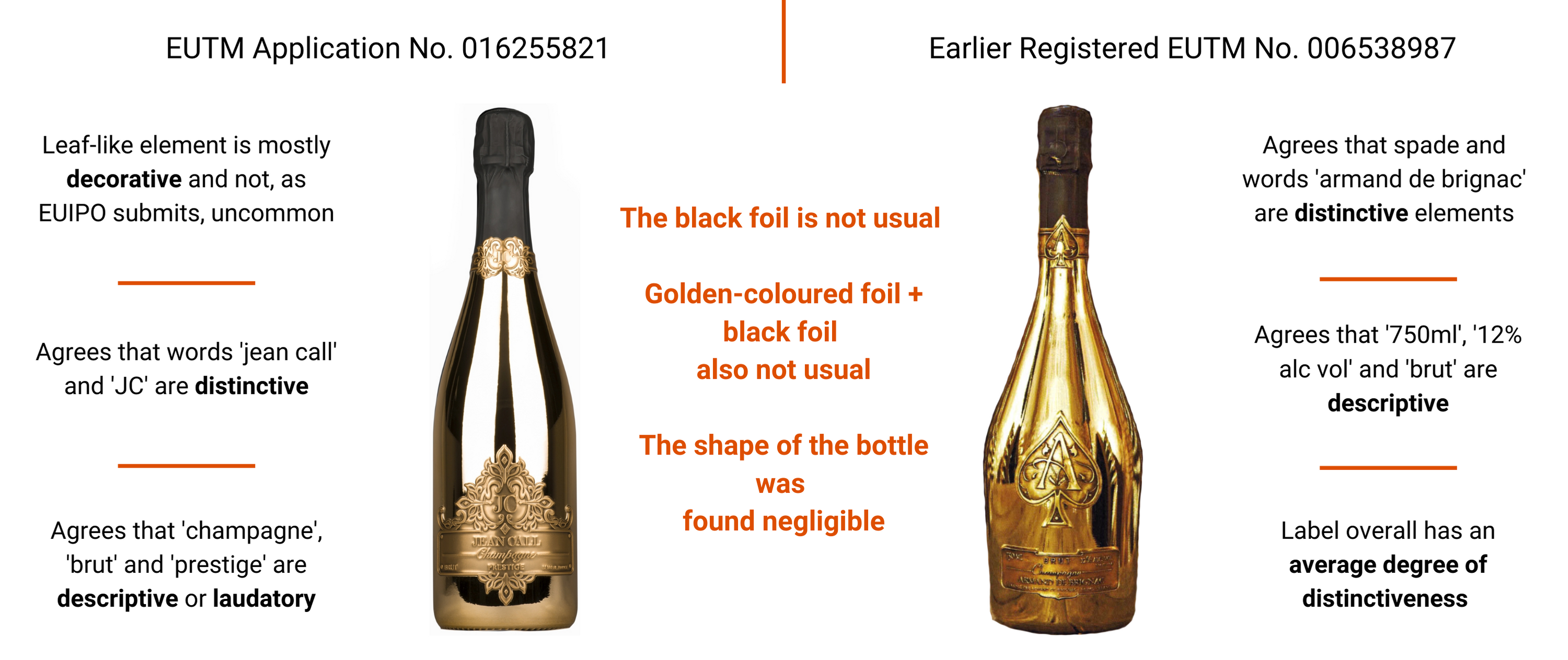We have come across three decisions (T‑620/19; T‑621/19; T‑622/19) from the General Court on the similarity of signs between Champagne bottle shape marks. The Court’s findings are interesting for three reasons:
-
There's always something to learn or discuss when the General Court annuls decisions from the EUIPO Boards of Appeal;
-
Non-traditional marks are rarely assessed in Luxembourg; and
-
There’s a certain difficulty in determining the weight of each element forming complex 3D marks
Background
Ace of Spades, is the company of music mogul and business man Jay-Z. Regarded as one of the most influential hip-hop artists in history, Jay-Z (born Shawn Corey Carter) took a 100 percent stake in Armand de Brignac champagne in 2014, but had ties to the company since 2006.
Known for having a reputation as a Champagne for parties, Ace of Spades is believed to be the only brand available in a 30-litre ‘Midas’ bottle size. Putting the extravagance aside, Ace of Spades recently brought oppositions against Munich Accessories GmbH’s EUTM applications for a total of three different champagne bottles, each as a 3D Unionmark, under the name “JC JEAN CALL Champagne”.
Ace of Spades (the Appellant) relied on Articles 8(1)(b) and (5) EUTMR and based the oppositions on the following earlier marks cumulatively.

The EUIPO’s decisions
The Office’s Opposition Division entirely rejected the oppositions finding that the signs were clearly dissimilar and there was no likelihood of confusion or need to assess the reputation of the earlier marks. The Fifth Board dismissed all the appeals carrying out a more detailed assessment of the signs and finding that there were no dominant elements and each application and the respective earlier marks coincided in certain non-distinctive elements, but differed in distinctive and more relevant ones. The Board also found that the evidence submitted by the Appellant was insufficient to demonstrate that the earlier marks were reputed. The Appellant brought the three cases to the General Court.
The General Court cited the usual corpus of law (inter alia C‑334/05 P Shaker, C‑705/17 Hansson and C‑193/06 P Nestlé) to lay out that a comparison of signs must be carried out by examining each of the marks in question as a whole, especially taking into account that neither the earlier marks nor the applications had dominant and distinctive elements. Furthermore, the descriptive, non-distinctive or weakly distinctive elements of a composite trade mark generally have less weight in the analysis.
Looking at the 3D marks in question, the General Court agreed that neither mark had dominant elements, but found that the Board had erred in appropriately weighting the relevance of the similar and dissimilar elements of the respective shapes. The assessment carried out in relation to the two shape marks in case no. T-622/19 is illustrated in further detail below:

Overall, the Court agreed that the marks differed in figurative elements and the respective distinctive word elements, but found that the shape of both bottles and the opaque, gold and black shiny foils had not been deemed negligible and, as the Appellant claimed, were rather unusual. Furthermore, the Court found that the combination of the shape of the bottle, the coloured foil and the top black foil constitute parts of the marks, which, as registered trade marks, are presumed to have distinctive character.
With this in mind, the General Court found that the Board only took into account the differences between the signs. Instead, it should have found that the signs were visually similar overall, even if some of the similar elements were weakly distinctive.
Therefore, the Court annulled the Board's decisions in so far as they dismissed the appeal brought by Ace of Spades and rejected the opposition based on Article 8(1)(b) EUTMR.
Conclusion and Key takeaways
Unless certain elements are negligible, an assessment takes into account the signs as a whole. There is certainly an enhanced difficulty in determining the weight of each element forming 3D marks in light of their likely complex nature. However, these decisions prove that the weakly distinctive character, or even the lack of distinctive character, of an element in common which is not negligible, cannot imply that the similarity resulting from that element in common will not have to be taken into account. For practitioners, this is a clear indication that every element counts and is worth being addressed.
Bonus – Assessment of the earlier mark’s reputation
The General Court also dedicated an additional 20 paragraphs to address the Appellant's plea in relation to Article 8(5) EUTMR. Among other things, it found that:
-
The percentage of relevant public which knows that mark may be taken into consideration, not that of people in general.
-
Tasting ratings and ranking of the Armand de Brignac trade mark does not make it reputed.
-
Evidence relating to the name Armand de Brignac is not sufficient to demonstrate reputation of the earlier shape marks.
-
Armand de Brignac Champagne may be renowned, but not the earlier marks.
What do you think about these decisions? Are shiny and black coloured foils that unusual in relation to Champagne? How do you prove that a 3D mark is reputed without relying on the name under which it's sold?
Need assistance in trade mark law?
Please contact Fernando or your usual Kilburn & Strode advisor if you have any questions.